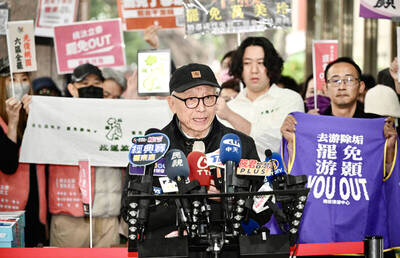Exhausted from a rising cost of living in the US and non-stop ads, some young adults on TikTok are pushing back.
“When every moment of your life feels like you’re being sold something and the price of said item keeps going up, people will burn out on spending money,” said Kara Perez, an influencer and financial educator.
Social media has long had room only for picture-perfect homes, lavish closets and an abundance of beauty products. But a new trend is sweeping the other way — urging repurposing, more frugal lifestyles and prioritizing quality over quantity.

Photo: AP
Known as “underconsumption core,” it spotlights living sustainably and using what you have, a reversal of the excess and wealth that dominates ad-heavy Instagram and TikTok.
“When you get 300 videos on TikTok about people who have 30 Stanley cups, you want to have as many as you can afford. People want to fit in,” said Perez, who repurposes jars as cups.
CONSUMER FATIGUE
A video with over 100,000 views from TikTok user loveofearthco critiqued the tendency toward overconsumption often amplified and encouraged on social media: “I spent money I didn’t have on things I didn’t need.”
Another account, nevadahuvenaars, shared what “normal” consumption looks like: used furniture, a modest closet, decor upcycled from glass bottles, meal prep and a downsized skincare collection.
Despite financial hardships felt particularly by Gen Z and millennials, the US economy is thriving, with record corporate profits and high prices on shelves.
In a way, “that feels almost ‘gaslighty’ to consumers” amid a period of economic and geopolitical uncertainty, said culture and consumer marketing analyst Tariro Makoni. She argued that Buy Now, Pay Later (BNPL) plans commonly adopted by many young adults’ budgets exacerbate consumption and represent a distortion in access to wealth.
But years of inflation have forced many to the conclusion that they cannot keep up with the spending habits of those on their social media feeds.
A Google Trends analysis shows US searches for “underconsumption” hit a high point this summer, surfacing alongside queries about “overproduction” and the “Great Depression.”
Many young adults have developed a “compulsive behavior to spend down to their last pound on a fashion item,” said UK-based influencer Andrea Cheong who recently shared an “underconsumption core” style video of her mending old clothes.
It is an addiction tied to a pressure “to articulate who we are through possessions,” Cheong noted.
In contrast, “underconsumption core” breaks from traditional core trends promoted by influencers, who often sell an ever changing purchasing blueprint embodying the latest trend and aesthetic, according to Cheong. She and Makoni agreed that the shift also reflects increased calls for authenticity from content creators.
Now, “conserving is cool” said Makoni — “we saw very similar patterns after 2008” during the financial crisis.
Over half of Gen Z adults — age 18 to 27 — polled in a 2024 survey by Bank of America stated the high cost of living as a top barrier to their financial success, adding that many do not make enough money to live the life they want.
SUSTAINABILITY CONCERNS
“The social media trend of ‘underconsumption’ is another way for Gen Z to make the most of their money and be environmentally friendly at the same time,” said Ashley Ross, head of consumer client experience and governance at Bank of America.
While younger generations worry about making sustainable choices, a lack of financial autonomy drives their decisions.
“Let’s be honest, no one’s gonna change their GDP for sustainability. We don’t live in that world ... The motivation for people to do these things has always been to save money,” said Cheong.
But she said “underconsumption” trends ultimately provide the most accessible approach to sustainability for those who seek it. The message is simple: “Buy less, buy better.”
Low consumption brick-and-mortar initiatives cast a wider net of profiles and generations.
Anjali Zielinski, 42, joined a “Mending 101” workshop in Georgetown, DC in the hopes of acquiring new skills. She brought her daughter, Mina, seven, along with her.
In addition to providing an outlet to her daughter’s creativity, she hopes the craft will teach her the “value of our possessions and the work that goes into them.”

The Democratic Progressive Party (DPP), Chinese Nationalist Party (KMT), and the country’s other political groups dare not offend religious groups, says Chen Lih-ming (陳立民), founder of the Taiwan Anti-Religion Alliance (台灣反宗教者聯盟). “It’s the same in other democracies, of course, but because political struggles in Taiwan are extraordinarily fierce, you’ll see candidates visiting several temples each day ahead of elections. That adds impetus to religion here,” says the retired college lecturer. In Japan’s most recent election, the Liberal Democratic Party lost many votes because of its ties to the Unification Church (“the Moonies”). Chen contrasts the progress made by anti-religion movements in

Taiwan doesn’t have a lot of railways, but its network has plenty of history. The government-owned entity that last year became the Taiwan Railway Corp (TRC) has been operating trains since 1891. During the 1895-1945 period of Japanese rule, the colonial government made huge investments in rail infrastructure. The northern port city of Keelung was connected to Kaohsiung in the south. New lines appeared in Pingtung, Yilan and the Hualien-Taitung region. Railway enthusiasts exploring Taiwan will find plenty to amuse themselves. Taipei will soon gain its second rail-themed museum. Elsewhere there’s a number of endearing branch lines and rolling-stock collections, some

Last week the State Department made several small changes to its Web information on Taiwan. First, it removed a statement saying that the US “does not support Taiwan independence.” The current statement now reads: “We oppose any unilateral changes to the status quo from either side. We expect cross-strait differences to be resolved by peaceful means, free from coercion, in a manner acceptable to the people on both sides of the Strait.” In 2022 the administration of Joe Biden also removed that verbiage, but after a month of pressure from the People’s Republic of China (PRC), reinstated it. The American

This was not supposed to be an election year. The local media is billing it as the “2025 great recall era” (2025大罷免時代) or the “2025 great recall wave” (2025大罷免潮), with many now just shortening it to “great recall.” As of this writing the number of campaigns that have submitted the requisite one percent of eligible voters signatures in legislative districts is 51 — 35 targeting Chinese Nationalist Party (KMT) caucus lawmakers and 16 targeting Democratic Progressive Party (DPP) lawmakers. The pan-green side has more as they started earlier. Many recall campaigns are billing themselves as “Winter Bluebirds” after the “Bluebird Action”